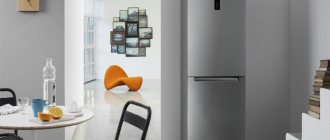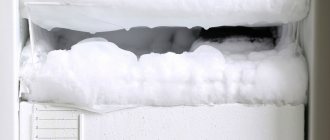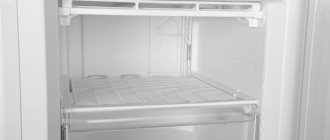It just so happens that the majority of the population of our country lives in “Khrushchev” buildings. We all know very well that the apartments in these houses are quite modest in size and if the need arises to purchase and install a second refrigerator, this will become a difficult task. But residents from the second floor and above have balconies at their disposal. Usually they are either completely unoccupied or minimally busy. In any case, there is enough space for them to install a refrigerator. Is this possible? Will he be able to work there and will he not fail? Let's try to figure it out.
The principle of operation of the freezer
Each device has its own requirements for operating conditions. They also include location characteristics. To find out whether it is possible to place a refrigerator on a balcony, you need to understand how the cooling process occurs.
Components of a conventional refrigerator:
- A compressor is a piston mechanism responsible for moving refrigerant.
- Evaporator – located in the walls of the refrigeration chamber, it takes heat from it.
- Condenser – transfers heat to the outside, located at the rear of the unit.
- The refrigerant (most often freon gas) is distilled by a compressor through pipelines and delivers heat to the condenser from the evaporator.
When liquid freon enters the evaporator, it becomes gaseous. Its temperature readings become lower than those inside the refrigerator. Therefore, the freon heats up and the chamber cools. The refrigerant is then distilled into a cooler where it cools and returns to liquid form. After freon enters the evaporator, the entire cycle begins again. Freon moves until the desired temperature inside the chamber is reached.
Refrigerants can move stably through pipes at a certain room temperature. Manufacturers create models that operate stably under standard environmental conditions. If in the middle part of the country the temperature in a residential building ranges from +17 to +30℃, then refrigeration equipment for these regions will work properly at such indicators. For southern tropical countries, both the temperature and humidity at which the refrigerator can be used will be different.
There is such a thing as climate classes. Information about them can be found in the product data sheet. The class value determines what ambient temperature range the device is designed for. This indicator is key when deciding to install a refrigerator on a balcony or loggia.
Main types of classes:
- N – from +16 to +32℃;
- SN – from +10 to +32℃;
- T – from +18 to +43℃;
- ST – from +18 to +38℃.
They are respectively designed for normal, subnormal, tropical and subtropical regions.
Is it possible to place a refrigerator on the balcony in winter?
Balconies and loggias can differ greatly from each other in the degree of protection from external conditions. There are several main types; let’s take a closer look at the possibility of installing refrigeration equipment on them.
Balcony without glazing and insulation
Placing a freezer on an open balcony is strictly prohibited!
Placing equipment on such a balcony is the same as on the street. It has no protection from severe frost or heat, from precipitation, dust, as well as insects and rodents. All this will lead to the following problems with technology:
- Formation of rust on metal parts from contact with precipitation.
- Increasing load on the compressor will lead to early wear of the equipment.
- Violation of the appearance of the equipment body.
- Damage to the seal from temperature changes, heat and frost will result in the door not fitting tightly to the body.
- Risk of fire from short circuit due to moisture getting into the electronics of the refrigerator.
Corrosion process on the surface of the evaporator.
Glazed balcony without additional insulation
A closed loggia is a more suitable place to keep a refrigerator. Glazing prevents direct precipitation from coming into contact with equipment, but condensation often forms on uninsulated balconies due to temperature changes. Moisture can get on the body, wires, and electrical parts of the refrigerator. “Cold” glazing does not provide good sealing, which means that some dust and precipitation will get inside, especially in the wind.
Even if you provide waterproofing, it will be impossible to maintain a suitable temperature in extreme cold and heat. If the air is warmer or colder than the data specified in the data sheet, the refrigerator simply will not turn on.
Note! If the freezer turns off almost immediately after turning it on, the operating temperature conditions were probably not maintained.
If the summer is not very hot, then it is possible to use the refrigerator in spring - autumn, and store food in the off mode in winter. Refrigerators do not have a warming function, and if the room is very cold, the device will not be able to function.
Glazed and insulated balcony
Warm glazing prevents the penetration of cold air from outside and does not let heat out. But in extreme cold, this may not be enough to maintain the operating temperature of the refrigerator (+16-+30℃). Then additional heating of the room is required. To do this, use heaters or install a heated floor system.
In addition, sun protection and ventilation will be required. Metal or plastic blinds and thick curtains reliably protect from sunlight.
“Warm” window profiles, insulation and the weight of the refrigerator will put a noticeable load on the balcony slab. It is important to take this into account and calculate in advance the maximum available weight of structures and equipment.
Please note: We organize a greenhouse for the balcony with our own hands: a greenhouse without leaving home
In the case where the loggia is attached to the room, there are no restrictions on the placement of refrigeration equipment there. In such a room the same microclimate is maintained as in the entire apartment.
How to replace a refrigerator on a loggia or balcony
As we found out, the main difficulty in operating compressor refrigeration equipment on cold balconies is associated with the presence of a refrigerant (freon) and a pump (compressor), for the normal functionality of which certain conditions must be met. However, you can cool food in another way by making a so-called thermobox with your own hands - a homemade refrigeration unit without a compressor and freon. The main advantage of such a device is its autonomy and compactness. That is, it does not require an electrical connection to operate, and you can use the thermal box even on a small balcony.
Features of a homemade design
Structurally, a self-contained refrigerator is a box, all surfaces of which have a high level of thermal insulation. Extruded polystyrene foam with a thickness of 3 cm and above is usually used as a thermal insulator. The polystyrene is covered with a layer of foil on top, which is designed to reflect external thermal radiation.
To create a low temperature, cold accumulators are located inside the thermobox. The basis of such elements is a special gel, which, after crystallization (freezing), is capable of maintaining low temperatures down to -20 ° C for a long time, creating the necessary conditions for storing and freezing food products.
This refrigerator can be placed on any balcony
Stages of assembling a refrigeration unit without a compressor and freon
To create a thermal box you will need the following materials:
- plywood;
- extruded polystyrene foam;
- adhesive foil;
- glue for insulation;
- sealant;
- screws, locks.
To make a mini-fridge with your own hands, you need to do the following work:
- Cut the sheet of plywood to the required dimensions and sand the surface.
- Assemble a wooden box.
- Prepare insulation for the walls, bottom and lid.
- Glue the insulation to the inner surfaces of the box using mounting adhesive.
- Putty and sand the places where the drawer is attached, achieving a smooth surface.
- Place foil on the outer surface.
- Make the internal lining from composite aluminum or foil insulation, then seal all joints.
- Attach the handle and locks to the lid.
- Prepare cold accumulators by placing them in the freezer for 2-3 hours.
- The compact thermal box is ready.
If it is not possible to place a refrigerator on the balcony due to the insufficiently insulated room, you can always find a way out of this situation. A homemade thermal box not only allows you to store food for a long time, but is also absolutely unpretentious in operation, which is the main reason for its use in unheated rooms.
YOU MAY ALSO BE INTERESTED
Is it possible to put a freezer on the balcony?
The conditions for placing a freezer on the balcony in winter are generally the same as for refrigerators. But there are nuances. The average temperature inside the chamber is -18℃. For the equipment to work, the air outside must be 2-3 degrees warmer. At -16℃ the device will work, but at maximum power. This will lead to rapid wear of the compressor and breakdown of the cooling system.
Important! Violation of the rules for operating devices specified in the instructions is grounds for refusal of free repair.
Whether to install a freezer on an insufficiently protected and insulated balcony is up to each owner to decide for himself. But it is important to understand what problems this can lead to. In addition to equipment failure, there is a risk of causing inconvenience to neighbors. Vibration from a working refrigerator can be transmitted along the walls and be felt by residents as a constant hum.
Among all types of balconies, the only suitable option for placement is a glazed, insulated loggia. But it is equally important to choose the right equipment model.
Difficulties in operation
But even if the balcony is glazed, you may encounter certain difficulties when storing a refrigerator on it. First of all, it is worth remembering that low temperatures can make it difficult for the device to operate . First of all, it's a matter of the thermostat. If heat does not come from outside, then due to the cumulative effect, sooner or later the equipment may stop working.
If you plan to place a Soviet-style refrigerator on the balcony, then you will have to face new problems. This technique runs on semi-synthetic or mineral oil. And at low temperatures they simply thicken. This doesn't happen right away, but over time you will notice changes. When the oil thickens, the compressor operates at almost full capacity. But this power is not always enough, which is why the protective relay is triggered. It is also important to remember that the rubber of the seal also does not survive the cold well - at low temperatures it loses flexibility and can burst.
But these problems are completely solvable. Service technicians offer several ways to solve them. First of all, if you have nowhere to put the refrigerator and you want to place it on the balcony, you need to make sure that it is glazed . Ideally, you also need to insulate the balcony . After all, in winter the temperature can drop very much. And in this case, even window frames will not save you from the cold. Here you will need full insulation of both windows and walls.
Also check that the room humidity is not very low - this is also quite dangerous. In such a room, the wiring may short out, as a result of which the equipment will simply burn out.
Operating a refrigerator on a balcony should be treated with extreme caution. It is better not to put sockets there. The most convenient option is to use a carrier. You also need to be sure that all wiring is carefully insulated. After all, cracked ones can lead to short circuits.
You install a refrigerator on the balcony, as they say, at your own peril and risk. But if you have nowhere to keep it in your apartment or you want to take the equipment out during repairs, then this can be done. It is not recommended to place it on the balcony in winter, especially if it is cold and open.
What kind of freezer can be installed on the balcony?
Freezers differ in design solutions:
- Chests are a horizontally located chamber with a door on top. Inside the chest is divided into compartments.
- Cabinets are no different in appearance from refrigerators. They have a vertical arrangement, the door opens from the front.
The choice of model depends on personal preferences, the size of the loggia and the types of products that you plan to store frozen.
Whether a freezer will work on a balcony in winter depends on the region for which it was manufactured (climate class). For regions with a mild climate, where the temperature in winter does not drop below +12℃, class N models are suitable. Provided that the freezer is placed on a balcony with glazing and insulation.
If there is nowhere else to put
If it is not possible to place the device in another location, the following recommendations should be followed:
- if you plan to store frozen food, you should purchase a freezer; it can operate at low temperatures;
- you should choose a refrigerator of the appropriate climate class (the best option is class SN-T);
- if the freezer is not in use, the refrigerator should be turned off at low temperatures;
- equipment should be protected from adverse external factors;
- You should purchase budget models.
Can it be stored on the balcony?
Manufacturers do not impose any requirements on storage conditions for equipment. Accordingly, storing equipment in the loggia is acceptable. In this case, it is necessary to exclude the effect of negative external factors (exposure to UV rays, precipitation). If you have to store a refrigerator in winter, then after moving it to a warm room, do not immediately turn on the equipment. You should wait a while for the components and oil to warm up.
Rules for installing and connecting the device
In addition to the temperature, humidity and strength of the balcony slab, the uninterrupted operation of the device is affected by proper installation and connection. These rules will help extend the life of the equipment and make the operating process safe:
- The base must be level and stable.
- The distance from the rear and side walls to the surfaces of the balcony must be at least 4-5 cm. This is necessary for sufficient air ventilation and to prevent overcooling of the device.
- It is not recommended to connect the device to the network through a carrying case. The outlet must meet all standards and be grounded.
- The device should not be located near batteries or heaters.
Wardrobe with built-in freezer for a heated balcony:
You can install the refrigerator on a glazed and well-insulated balcony. It would be good if it would be possible to additionally heat it in cold weather, as well as cool it in hot weather.
The technologies used in the latest models allow the device to operate even at ambient temperatures up to +5℃. At the same time, the load on all systems will be increased, which can lead to early wear of the equipment. Repair under warranty in this case is impossible, since the operating conditions were violated. If you have an old device, for which the warranty has long expired and you don’t mind parting with it if it breaks, then you can try placing it on the balcony. In any case, it is important to ensure fire safety and ensure the stability of the balcony base.
What is dangerous for a refrigerator when installed on a balcony?
Before installing a refrigerator on the balcony, you need to take into account all the risks and take into account many negative factors that will negatively affect the performance and condition of household appliances:
- The recommended temperature range for modern refrigerators used in our country is 15-35 degrees, which is very difficult to maintain on an unheated balcony;
- Don’t forget about electrical safety, which is why many experts categorically do not recommend installing tees and various extension cords on balconies;
- If the equipment is installed on an open balcony or near an open window, the body of the refrigerator may be exposed to snow, rain and other precipitation, which will quickly lead to damage to the working elements of the refrigerator and their failure;
- A high level of humidity, which will certainly be combined with a low temperature, will reduce the operating life of the refrigerator to a minimum;
- Having installed the refrigerator on the balcony, you will also need to consider its use in the summer, when the body of the equipment will become very hot due to sunlight, which can cause damage to the insulation of cables and rubber parts;
- In addition, a high level of heating will increase the pressure in the cooling system, so the refrigerator will work constantly, without interruption, which also negatively affects its performance.
These problems are relevant if the refrigerator or freezer on the balcony is located in an unheated and unglazed room.
Storing vegetables, fruits and other products on an unglazed balcony in winter is also possible outside the refrigerator.
Please note: How to properly store potatoes on your home balcony: containers and conditions
At what sub-zero temperature can a refrigerator operate?
Can a refrigerator work in cold weather? The marking of any refrigeration equipment includes a climate class, which determines the operating temperature range for a particular device. This classification has 5 categories:
- SN – subnormal class (+10 °C ÷ +32 °C).
- N – normal class (+16 °C ÷ +32 °C).
- ST – subtropical class (+16 °C ÷ +38 °C).
- S – tropical class (+16 °C ÷ +43 °C).
- SN-T – universal class (+10 °C ÷ +43 °C).
As you can see, not a single climate class requires the device to operate at subzero temperatures, and it is not by chance that manufacturers introduce such a restriction. When using a refrigerator on an unheated balcony in winter, you need to be prepared for the following emergency situations:
- Thermostat operation in single-circuit cooling systems. The switching on and off of the compressor is controlled by a temperature sensor, which is usually installed at the top of the refrigerator. The thermostat contacts open and, accordingly, turn off the compressor when the internal temperature of the refrigerator compartment drops to a predetermined level. If a situation arises in which the air temperature on the balcony corresponds to the temperature sensor setting (for example, +5 °C), that is, heat from outside stops flowing, the device will be constantly off. This is not critical for cooling and storing food, but you can forget about the freezing mode, at least until the external temperature increases.
In single-circuit systems, the operation of the refrigerator and freezer compartments is regulated by one temperature sensor
- Compressor oil. Some refrigerator models run on mineral oil, the viscosity of which increases significantly if the ambient temperature drops below +5 °C. Starting the compressor engine in this case will be “difficult”, so regular operation in such conditions increases the likelihood of unit failure.
- Wet running effect. Due to incorrect temperature conditions, the process of converting liquid freon into vapor is disrupted, so after the evaporator, gas saturated with liquid will enter the compressor. Wet running can cause significant damage to compressor equipment, often causing water hammer.
- Ice growths. In “crying” models, between switching cycles, the ice accumulated on the evaporator thaws, and the collected moisture is removed through a special hole in the rear wall of the refrigerator. In winter, normal heat exchange on the balcony is often disrupted, as a result of which an ice layer gradually accumulates on the evaporator and the wall, which can reach large volumes.
Ice buildup is a typical problem when operating a refrigerator in an unheated room.
- Safety precautions. On a balcony, especially an unglazed one, the humidity level usually exceeds the values permissible for the safe operation of household appliances. Moisture on electrically conductive parts can be hazardous to both equipment and people.
Is it possible to place a refrigerator on an unheated balcony?
It was already noted above that the refrigerator and freezer will not work properly in low temperature conditions. It is quite possible to turn them off in an emergency under extreme operating conditions. Of course, it is possible that the equipment will be used on the balcony in the warm season, and driven back into the kitchen in winter, but this approach is irrational and extremely inconvenient.
General diagram of the refrigerator operation.
If heat exchangers - 1 and 3 freeze, and the oil in compressor - 4 thickens from the cold, then expander - 2 will stop working and the refrigerator will fail.
If the balcony or loggia has high-quality glazing, then these rooms can be additionally heated. For this, a variety of devices can be used: heated floors, oil, infrared, electric heaters - everything is up to the owners’ choice. But you need to understand that constantly heating such a cold room to the required temperatures may well lead to serious electricity costs, because the heaters will work constantly in such conditions.
It is not recommended to place a refrigerator or freezer on the balcony if the room does not have high-quality insulation and glazing.
In difficult operating conditions, the equipment will work irregularly, constantly turn off, and its service life will be reduced.
Organizing a cellar on the balcony with your own hands
Such a cellar, as a rule, is a stationary, insulated box of dimensions specified by the master, in which a slightly positive temperature is artificially maintained (only heating is carried out when the temperature on the balcony drops to 0 or below) from autumn to spring.
Let's consider how to make a cellar of this type on the balcony:
- The inner box of the container is constructed from boards, slats and beams, after pre-impregnating the wooden materials with machine oil to avoid rotting. Diesel fuel can also be used.
- The walls of the box are lined with polystyrene foam boards. The final thickness of the insulation of the balcony box should be 5-10 cm, depending on the climate. It is better to use slabs in 2 layers and lay them staggered to avoid heat leakage through the joints.
- In the corners and at the joints the insulation is sealed with polyurethane foam.
- A door is made and adjusted to the dimensions and configuration of the container opening so that the side edges of the door are beveled for a density of 3 cm per 10 cm thickness. The door is insulated with mineral wool and covered with moisture-resistant plywood on top. The lid is installed with an overlap for more convenient gripping and lifting.
- The lid is secured to the box using metal hinges.
- The bottom of the box is made in the same way as the walls - from boards and insulation for the balcony. after which it is connected to the common frame.
- On top of the insulation, all outer planes of the cellar are also finished with wooden material, which serves as an additional means of insulation from moisture and cold and at the same time gives the structure a normal appearance.
- At the bottom inside the cellar there is a socket with a 75-watt light bulb, which, in fact, will serve as a means of heating, maintaining the temperature in the container above zero. A protective casing is arranged for it so that the light does not scatter inside the container and to avoid accidental damage to the lamp. The cartridge is “powered” from a regular outlet.
This method requires personal monitoring of the temperature on the balcony and manually turning on the lamp if necessary. If desired, you can organize automatic control of the temperature and on/off the light bulb by installing a temperature sensor with a relay system in the cellar, but this will slightly increase the cost of the design.
On a note! It is better to place vegetables inside the container in boxes, such as plastic ones for apples. This will ensure normal air circulation and uniform temperature distribution in the box.
What to consider when choosing cellar ventilation methods
Usually the cellar on the balcony is not used for one thing. Housewives, in addition to agricultural products, hide flower bulbs, canned food, and dried fruits there. This set requires different storage conditions. Then the space inside the cellar is divided into zones, selecting a special air circulation mode for each.
Vegetables and fruits, like all living things, breathe. Apples adjacent to potatoes will absorb the potato smell. The whole house will smell like onions if you don’t use forced ventilation.
To do this, one end of a long plastic pipe is inserted into the container to its full height. The other end leads outside from the balcony. Buy a regular electric fan for the wall. Due to the temperature difference, the air exchange process occurs. This is done when the cellar for storing supplies is spacious.
How to provide heating for a cellar
The Internet is full of various ideas for how to heat cellars. The most modern solution is safe tape heaters, silicone blankets . The electronic thermostat TRO-02 is intended for balcony cellars. The device operates on AC power. The heating element is connected through the terminals and placed inside along with the sensor. The thermostat itself is attached externally to protect against condensation.
You can screw 2 light bulbs 40-60 W into the cellar . Their heat will warm 1 m3 of closed space. Some inventors, wanting to improve the cellar, play tricks with parts from used electrical appliances. Don't take risks! Fire safety rules have not been canceled. A DIY balcony cellar should be comfortable and safe!
If you need to store vegetables for a short period of time, it is better to use a special box.
Features of the finished cellar for the balcony
It won’t be difficult to purchase a balcony cellar of this type today.
Features of the finished balcony storage for vegetables are as follows::
- It usually consists of multi-layer waterproof fabric. inside which there is usually a synthetic winterizer thermal insulation layer.
- The entire fabric is penetrated with small heating electrodes. through which the temperature inside the cellar increases if it drops to a given level.
- In addition, finished products are equipped with a thermostat with an external screen. The sensor sets temperature limits suitable for storing food. When the temperature drops below the lower threshold, the heating of the cellar is automatically turned on; when the upper threshold is reached, the heating stops.
- The energy consumption of such products is quite low and, depending on their volume and temperature conditions, is up to 1.5 kW per day.
- Containers are available in various volumes and color variations, making it easier to select a product for specific needs.
Installing a refrigerator on a glazed balcony
It is impossible to immediately say whether it is possible to place a refrigerator on the balcony for storing vegetables and fruits if it is completely glazed. The fact is that balconies and loggias, regardless of the level of glazing and insulation, are not residential premises, so it is quite difficult to ensure the required level of temperature and humidity in them, which will be optimal for the operation of household appliances.
It is quite possible to consider the option of replacing the refrigerant in the refrigerator with a lower temperature one if it is expected to constantly operate on a glazed but unheated balcony.
Refrigerator in a niche on the balcony.
Any refrigerator repairman can replace the refrigerant. In addition, in addition to the refrigerant, you will also have to change the oil for the compressor, which will have normal viscosity even at low temperatures. It is important that the technician called is experienced and has certain knowledge in this area, because the selected refrigerant and oil must fully comply with the characteristics of the equipment and be able to maintain the normal functioning of the refrigerator. Some modern models, by the way, use a special refrigerant, which is used together with oil based on semi-vinyl esters, which can work quite well at low temperatures in winter.
You can also consider an exotic option - purchasing a display refrigerator, usually they sell ice cream.
They can be used in conditions of any temperature, both summer and winter. They can be placed on a balcony or loggia, regardless of insulation and glazing. At the same time, manufacturers do not recommend the operation of such equipment when the temperature drops to -5, -7 degrees. And in winter it is often colder on the balcony. It is important to note that display refrigerators are quite large and cost much more than household models, so placing them on your balcony will be problematic.
Tips for use
The refrigerator should be installed so that it is not exposed to direct sunlight.
This can be avoided by closing the balcony windows with thick curtains or blinds. For the refrigerator to function properly, there must be ventilation in the room, which means that the balcony must be ventilated regularly. When trying to create the required temperature regime, you should not install heaters with spirals near the refrigerator. This can not only overheat the refrigerator, but also cause a fire. To ensure normal functioning of the refrigerator in a balcony environment, at a minimum, the following must be observed:
- the device must be installed so that there is a distance of at least twenty centimeters from it to the walls;
- the electrical outlet must work properly and have reliable protection;
- Electrical wiring should be insulated and placed inside a box that will protect it from rodents.
If you manage to ensure that all the requirements for operation on the balcony are met, then you can safely remove the refrigerator from the kitchen.
Installation on a balcony connected to the kitchen
The most suitable option for installing a refrigerator for vegetables and other products outside the kitchen. If the apartment has been remodeled and the balcony has been added to the kitchen, then it becomes one with this room, so there is nothing wrong with installing equipment near the window. At the same time, special attention should be paid to electrical safety, because even on attached loggias and balconies it is necessary to install sockets and switches with a high degree of protection. You can use a well-insulated and protected extension cord.
Refrigerator in attached room.
At the same time, it is important to place the refrigerator for vegetables and other products in a place on the balcony where it will not be exposed to direct sunlight. It is very good if blinds are installed on the windows or dark curtains are hung. Keeping such equipment under the sun is very dangerous, because it can fail due to overheating (including in winter). Also, do not forget about systematic ventilation of the room, for which special ventilation valves that are installed on modern plastic windows are excellent.
High-quality ventilation of the balcony and kitchen is especially important if the window faces the sunny side.
In this case, both in summer and winter, the air in the room will be seriously heated (taking into account the operation of the radiators), so it can be quite hot on the balcony in direct sunlight, which also negatively affects the normal functioning of the equipment.
Design Features
In a small modern apartment, every meter is valuable. Therefore, when an opportunity arises to save some space, everyone rushes to take advantage of it. And if you decide to move the refrigerator onto the balcony or turn the loggia into an extension of your kitchen, then it is not necessary to sacrifice the beauty of the room. As customer reviews prove, the design of a balcony with a refrigerator can be quite interesting.
An enclosed balcony can be turned into a kitchen workspace by installing a refrigerator, several cabinets and a table. This way it will be very convenient for you to cook. And in the kitchen itself you can install a table with chairs. This way you will have more free space for family lunches and dinners, as well as for gatherings with friends.
A refrigerator can fit quite organically into a kitchen set. It can be classic white or stylized as wood - in any case it will look organic and very beautiful.
Experts advise avoiding the proximity of a refrigerator to a gas stove, so it should be located in the kitchen. But this is still a fairly convenient option, especially if the balcony space is connected to the kitchen space.
If you like to stock up on frozen vegetables and meat for the winter, then on the balcony you can install not only a refrigerator, but also a large freezer. This way they will not take up free space in the apartment itself, and you will have a good supply of food.
In this video, the author will show you how you can wisely use the space on the balcony and correctly install a freezer in the closet.
In general, the refrigerator can be installed both on the balcony and on a simple loggia. The main thing is, before you take it out there, make sure that you can create normal conditions for storing and operating this equipment. This will extend its service life and ensure normal operation.
Install the equipment in a room with suitable conditions, and it will delight you for a long time with its high-quality work and neat appearance.
Summary
From all of the above, we can conclude that it is not recommended to install the refrigerator on unglazed and unheated balconies. If the loggia or balcony has glazing, then for the normal functioning of the equipment you need to create all the conditions (installation of heaters, ventilation, protection from the sun, etc.), otherwise the refrigerator will quickly fail.
Please note: How to get rid of condensation on the balcony?
In addition, when installing a refrigerator on a balcony (on a balcony, not in a loggia), you need to take into account the strength of the load-bearing concrete slab (especially in old houses). It is quite possible that it is not designed for heavy loads. And glazing, finishing materials and supplied equipment will create a very significant load on the floor.
A fun way to use an old refrigerator. If you install the pipe on the side, you can also use a working refrigerator on a glassed-in balcony and turn it on only in the summer. Video below.
As an alternative to a regular refrigerator, you can consider purchasing soft thermal containers, which are great for storing vegetables, fruits and other products in winter. Such containers for storing vegetables are used in many countries around the world.
https://www.youtube.com/embed
Balcony slab load
There is another obstacle to installing a freezer on a balcony, even if it is reliably insulated and equipped with a “warm floor” system.
During insulation of the balcony structure, the load on the balcony slab increases, because additional frames with double-glazed windows are installed (plastic windows have quite a significant weight); lay the screed; make a frame for insulation from a metal profile or a wooden block; sheathing the walls and ceiling with various building materials; lay the finishing floor covering (if ceramic tiles or natural stone tiles are laid on the balcony, this will significantly increase the load), install drains and a canopy.
With an increased load on the balcony slab, especially if the balcony has been used for a long time in open conditions, under the influence of the atmosphere and precipitation, there are chips of concrete and exposed reinforcement, there is a real threat of a significant reduction in the load-bearing capacity of the structure.
In this case, even an empty freezer on the loggia will be an additional load on the dilapidated structure, because the weight of a Liebherr brand refrigerator (for example) is 89 kg, and when fully loaded with food, this figure will increase to over 120 kg. The vibration created by a running refrigeration unit will also have a negative impact on the balcony slab.
How to fit a refrigerator in a tiny apartment? To be able, you need to be able. Be able to weigh the pros and cons, and refuse to install the refrigerator on the balcony, so as not to cause an emergency situation due to the collapse of the slab.
Secrets of technology
The basis for the operation of any refrigerator is the principle of phase transition - the phenomenon of changing the aggregate states of substances (from gas to liquid and vice versa). The described physical process is accompanied by another phenomenon - the absorption or formation of a significant amount of heat. The operation of the refrigerator is based on a similar system; refrigerant (freon) is used as a liquid instead of water. In order to understand the effect of freon on cooling the contents of refrigerators, you should know its main characteristics.
- The boiling point of the refrigerant charged into the system is below zero degrees Celsius.
- The process of freon boiling is accompanied by the absorption of warm air from the refrigerator, creating an optimal temperature.
- Thanks to the presence of a compressor, at the next stage freon turns back into liquid.
- The heat generated in the process escapes through the back wall of the refrigerator (heat exchanger).
This is how a refrigerator works
Since the temperature of the living space is above zero degrees, ideal operating conditions for the refrigerant are created. Accordingly, the uninterrupted operation of refrigeration units is ensured by a positive temperature in the room.
It should be noted that manufacturers of modern household appliances have developed special systems in refrigerators that are capable of efficiently performing their functions in different climatic latitudes and temperature conditions.
How does a compressor refrigerator work?
The main task of any refrigerator is to remove heat from the internal compartments and maintain a low temperature at a given level. Heat exchange between the internal and external spaces is carried out due to a special substance - a refrigerant, which easily passes from liquid to gaseous state under the influence of changing temperature and pressure.
Balcony as an alternative place for storing and freezing food
For your information! Freon, a compound of carbon, chlorine and fluorine, is usually used as a refrigerant. Chemically, this substance is very inert, so it does not ignite even when in contact with an open flame. Therefore, refrigeration units operating on this gas have a high level of explosion safety.
As you know from a physics course, when a substance transitions from a liquid to a gas (boiling process), thermal energy is consumed, and when it transitions back from gas to liquid (condensation process), heat is released. The operation of a household refrigerator, which consists of an evaporator, a condenser and a compressor that sets the pressure for freon, is based on this principle. Heat is removed from the refrigeration compartments as follows:
- In the evaporator, which is usually located near the freezer, the refrigerant is under pressure below atmospheric pressure, so it boils even at negative temperatures. During the process of evaporation of the refrigerant, heat is removed from the refrigeration chambers.
- The vaporous substance enters the compressor, where it is compressed to a pressure above atmospheric. When compressed, the freon temperature also increases, which can reach 100 °C.
- Since the boiling point of the substance increases with increasing pressure, after entering the condenser, freon turns from vapor into liquid, releasing accumulated heat to the external environment.
- The condenser and evaporator are connected to each other by a thin capillary (throttle), thanks to which the high pressure required for the operation of the condensation sector is converted into the low pressure necessary for the evaporation of the refrigerant. Thus, the heat exchange cycle is repeated continuously.
The principle of operation of the refrigerator
Basic requirements for the premises
In order to finally understand where it is permissible to store and efficiently use the functions of refrigerators, it is worth finding out the main requirements for the premises. There are few rules and they are all important.
- The best option is frequently ventilated rooms.
- The refrigerator will be uncomfortable in direct sunlight (danger of freon overheating, a direct path to system failure).
- Humidity is below 80 percent.
- It is important to protect household appliances from precipitation.
Conclusion: refrigerators can be stored on loggias with above-zero temperatures, protected from rain and snow.
There are a number of nuances that should be taken into account when placing the refrigerator on different types of balconies.
Loggia room
Many owners expand the living space of the apartment by adding a loggia to the room. Typically, balconies-rooms (insulated) are the best choice for placing a refrigerator. The only problem is the lack of an outlet on the balcony premises: according to the rules for the safe operation of loggias, it is prohibited to conduct electricity there. Therefore, you will have to buy an extension cord in order to connect the equipment to the network using a room outlet.
Glazed option
Glazed loggias are:
- insulated;
- not insulated.
Choose the darkest place for your refrigerator
Glazed balconies with an entrance to the kitchen differ from attached balconies in that they do not have the status of a living space; it is colder on the loggias than inside the apartment. The refrigerator runs smoothly and stays warm. Therefore, if the loggia is not insulated (16-32 degrees Celsius), breakdowns may occur in the refrigerator, particularly in winter.
To avoid such troubles, there are several practical recommendations. Firstly, use the refrigerator on the loggia only during warm periods, and store food in winter without using household appliances. Secondly, move the refrigerator into the apartment for the winter months. The third option is to provide heating for the balcony room.
The presence of an insulated loggia “on-site” eliminates a number of the problems described above: in a heated room, the air temperature remains pleasant to the refrigerator at all times.
Without "glass"
It is better not to keep equipment on completely open balconies. There is a rational explanation for this:
Homemade refrigerator for the balcony
- the balcony does not protect from direct rays of the sun, precipitation, wind;
- manufacturers refuse warranty service for equipment used outdoors;
- sudden changes in temperature conditions and humidity significantly accelerate the period of wear of the unit;
- the anti-corrosion coating deteriorates quite quickly in “open” conditions;
- rubber parts lose elasticity.
If the owner values the equipment, it should not be exposed to the sun or rain or snow.
You have nowhere to put the refrigerator: what to do?
Contrary to your fears, you decided to move the refrigerator to the balcony, since there is simply nowhere else to put it. It is important to consider two aspects of this decision: rational and safe. Follow these recommendations if you are determined to break the rules.
- Think about why you need a refrigerator on the loggia. If you plan to keep fruits, mushrooms, and meat products in it, then you should choose a freezer. Are you planning on stocking your fridge with carbonated drinks that are available on any hot day? Choose the unit class ST or T without a freezer. You can get two in one if you get Full No Frost equipment.
- Check that the climate class correlates with seasonal temperature. Are you sure that the heat will not rise above +30? You can bet without any doubt. But if you make a mistake with the weather, the compressor will only work for a season or two.
- If you do not use a freezer, then unplug the refrigerator at temperatures below +10. By adjusting this issue, you will be able to turn the unit on and off according to the changing weather outside, without fear of harming the equipment.
- Do not expose the refrigerator to sunlight. Take care when purchasing roller blinds or blinds so that the paintwork does not deteriorate and the rubber seal does not crack.
- Buy a budget model. This way, at least you won’t be so annoyed if the refrigerator does break down. Soviet units often become permanent “residents” of balconies, because the warranty and operational period have long expired, but they continue to work, and it is a pity to dispose of them.
- Protect equipment from moisture. Glaze the loggia, think over a ventilation system, or simply open the windows.











